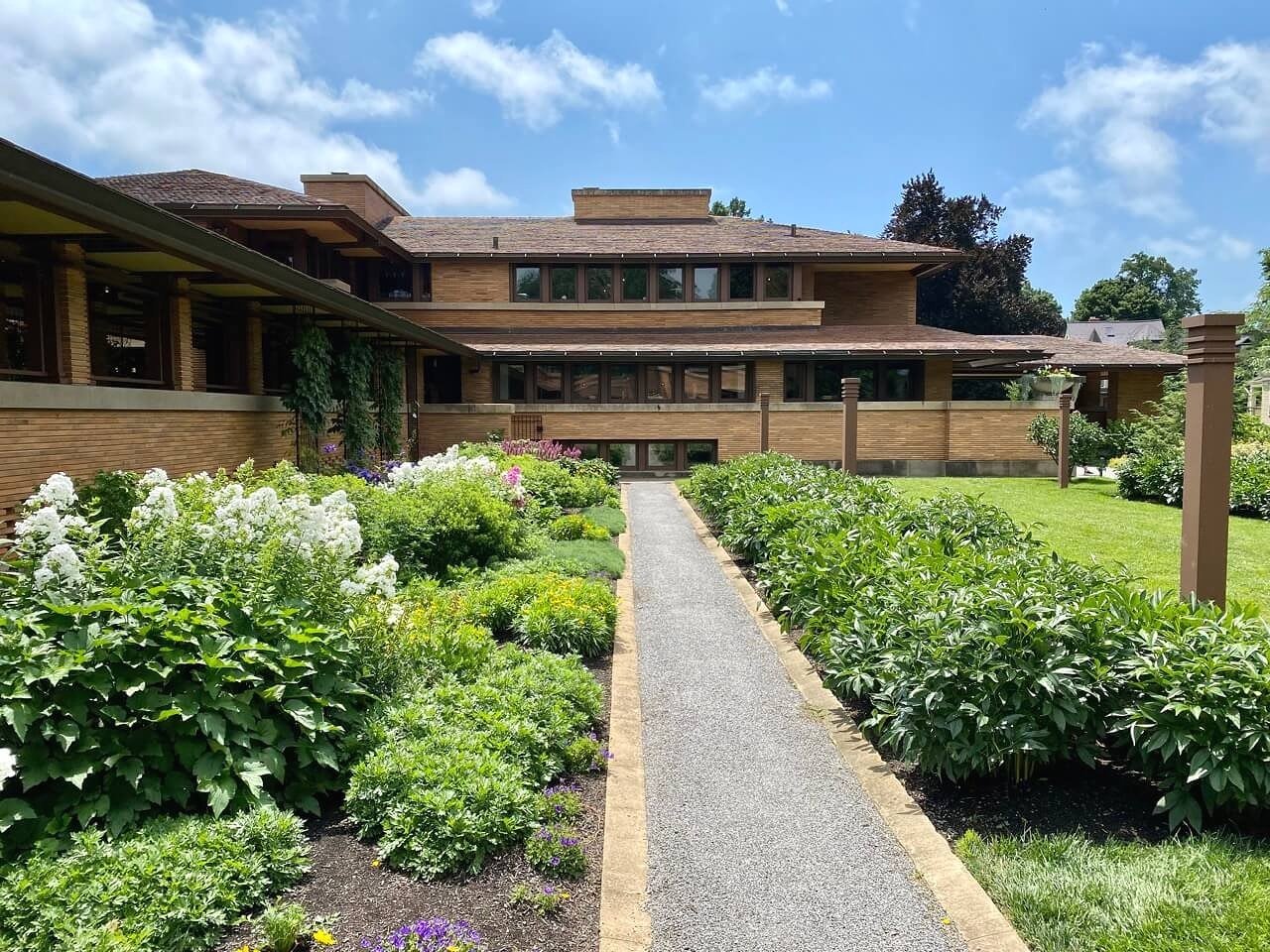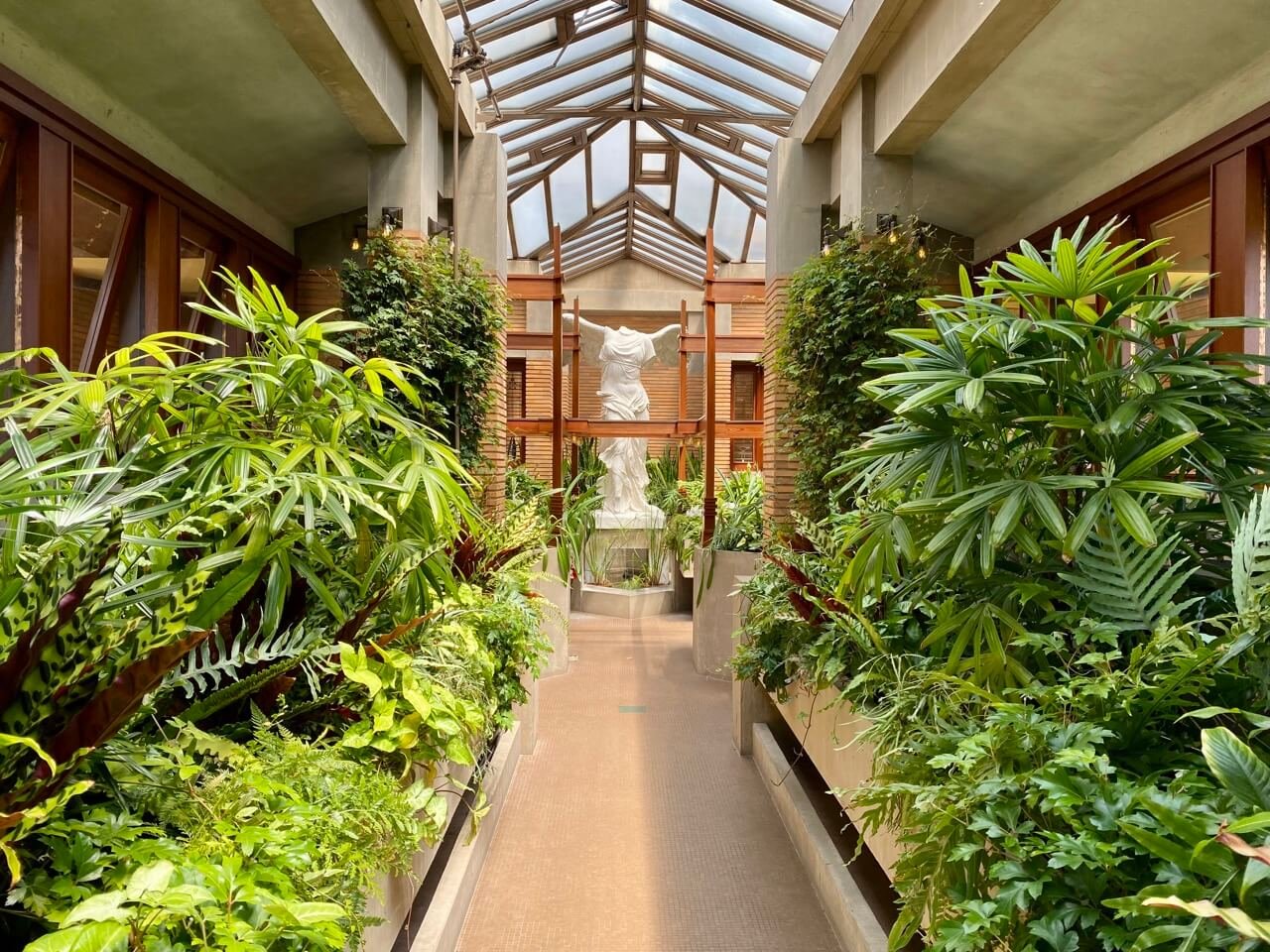Visiting The Martin House: The Frank Lloyd Wright Masterpiece in Buffalo, NY
The Martin House is, simply put, one of Frank Lloyd Wright’s most important projects. This national historic landmark has been stunningly restored over the years to be ready for your visit—one that’s well worth making.
The view of the Darwin D. Martin House from the other side of The Pergola.
The Wright scholar Robert McCarter once said about the Martin House Complex that it was “the most important house design of the first half of Wright's career, matched only by Fallingwater over 30 years later.”
I’m no Wright scholar (not yet, at least), but having had the pleasure of visiting the Martin House in Buffalo, New York, I’m not remotely surprised by such a statement. From the moment we arrived, both Bri and I were utterly taken with the property. With Wright’s attention to detail and notable eccentricity and intentionality, it was, in a sense, like having the chance to walk through a revered painting.
Definitely keep reading if you’re planning on visiting the Martin House, but if you’re planning a larger trip to Buffalo, make sure you check out the many articles we have on our site. We’ve written about the top things to do in Buffalo, visiting Buffalo’s museums and galleries, and visiting Duende at Silo City, to name a few. Plus, if you’re looking for a great place to stay, we’d highly recommend staying at an historic property in Buffalo, like the InnBuffalo Off Elmwood, or the Richardson Hotel.
Please note that this post contains affiliate links. Simply put, this means we may receive a small commission for some of our heartfelt and honest recommendations.
Who Was Frank Lloyd Wright?
Widely considered to be one of the most influential figures in modern architecture, Frank Lloyd Wright (1867-1959) worked under the mentorship of Louis Sullivan, who has been referred to as the "father of skyscrapers.” Wright established his own architectural practice in 1893 in Oak Park, Illinois where he developed his distinctive Prairie School style of architecture. His philosophy of organic architecture sought to find harmonies between architecture and the natural world.
During his career, Wright designed more than 1,000 structures, of which 500 saw completion. His designs can be found across many parts of the United States, and include notable places like Fallingwater, Hollyhock House and even the Guggenheim Museum in New York City. His holistic approach to architecture has influenced generations of architects, and shaped the course of modern architecture.
For anyone who is a fan of mid-century modern design, like Bri and I are, it will come as a surprise to see Wright’s early designs showing signs of MCM long before the mid-20th century.
Visiting the Martin House Today
I've visited many historic properties and museums in Buffalo, and it’s also worth noting that the dedication of the staff at the Martin House is something else. I don’t think there was a single question asked throughout our tour that wasn’t answered in full by our guide, Pat.
When you arrive, you’ll head to a modern welcome centre, which serves the function of getting tours organized and also showcases a helpful video to contextualize what you’re about to experience (at least on most tours). The Martin House knows very clearly that, put plainly, this complex is one of the greatest works from one of the greatest American architects to ever walk the planet.
How the Martin House Came to Be
The east side of the house showcases the Martin House verandah.
Martin House was built between 1903 and 1905, though I would believe it’s from 50 years later if I didn’t know any better. Frank Lloyd Wright was a playful visionary, so in the Martin House, we see him laying the groundwork for not only some of his future work but also for future trends in architecture at large.
Wright designed Martin House for his friend and business associate Darwin D. Martin. Diving into the history, you get the sense that Martin didn’t end up having too much say in how the building unfolded, especially as it relates to cost. Wright was a smart man, so it wasn’t lost on him that Martin, a very prominent business leader in Buffalo, had deep enough pockets to support even his most ambitious designs.
At the time, houses really weren’t meant to be so open and have so much flow from one room into the other. Frank Lloyd Wright, as an architect, seemed to care very little about adhering to established trends (he was much more interested in establishing them), so it’s no surprise that in many ways Martin House appeals to our modern conceptions of “openness,” though it certainly would have given the Martin family a cause for pause.
Wright played with construction methods (pier and cantilever), and especially during his Prairie House period, was also obsessive about utilizing not only natural colour, but also natural materials. As the Martin House notes on their site:
“Wright redefined traditional concepts of structure and space by connecting the built environment to the natural world.”
The property itself includes much more than just the main house. It was, in truth, significantly larger than I thought it was going to be. It’s as if the main house is the heart, and it has all of these arteries that lead to other houses, cottages, sheds and more. The bulk of your time with be spent in the nearly fifteen thousand square foot Darwin D. Martin House, but I will touch on the estate at large below.
One thing that I did not know prior - Martin House was abandoned following the period in which the Martins lived there. According to some accounts, it was borderline derelict at points, but in 1992 a committed and worthy restoration effort began, and it was completed some 20 years later, in 2019.
Having visited after the restoration and having seen just how much work had to be done, I am filled with gratitude because the Martin House is a place that should be propped up and appreciated - largely because as historic sites go, there’s nowhere else like it.
What Does the Martin House Estate Consist Of?
In short, a lot. The estate itself is technically located in Buffalo’s historic Parkside neighbourhood, and it takes up almost 1.5 acres of that neighbourhood!
1. The Darwin D. Martin House: Coming in at 15,000 square feet, this is the place where you’ll be spending most of your time. It’s enormous, but I’d urge you not to get caught up in its size and notice the details. For example, look carefully at the art glass around the house. You’ll see sixteen different unique patterns implemented here - more than any other property he built during this time.
The double-sided fireplace that you’ll encounter when you first enter struck me as equal parts impressive and impractical, but as with everything with Frank Lloyd Wright, it just works.
Here, let your guide, guide you. Keep your eyes and ears wide open, and there’s no doubt you’ll leave the estate at large brimming with curiosity and intrigue.
2. The Pergola: I was enamoured with this section of the home. Photographers may want to know that you can take pictures here, since it’s outdoors. In practice, it’s merely the covered walkway that leads from the main residence to the Conservatory. In principle, it’s something else altogether, and the framed views here of other sections of the estate are breathtaking.
3. The Conservatory: A glass-enclosed garden that, of course, features an array of rare and tropical plants. The answer is yes - it’s as cool as it sounds. The light streams in from the skylight, and makes sure you can’t miss the full-size replica of the “Winged Victory of Samothrace,” a sculpture that Frank Lloyd Wright tried to make sure you could see from the entrance of the Darwin D. Martin House.
4. The George and Delta Barton House: Darwin hired Frank to create a home for his sister and brother-in-law, and this was actually the first property that was built. Many people feel it was in the building of this home for George Barton and his wife that Wright was able to actualize his vision and, in a sense, prove his ambitious project (the Darwin D. Martin House) was viable. Another “Prairie Style” home to go and admire, just on a smaller scale. For reference, it’s less than a third the size of The Martin House.
5. The Carriage House: This building was both a barn and a garage. There needed to be space for both horses and cars - talk about a sign of the times in which the estate was constructed. Nowadays, it serves as the awfully picturesque and well manicured Museum Store.
6. The Gardener’s Cottage: When you see the gardens and landscaping on the estate, you’ll immediately understand why there needed to be a home for the gardener and their respective family. Note the built-in planters inside, a nod to the function of this cottage. By the way, if you’re visiting with landscaping in mind, you may want to check out Martin House’s guide to the most asked about plants.
A word of advice - before you arrive, you may want to also take a look at the works of art and objects that you’ll encounter during your visit. The collection includes everything from art glass to furniture, prints to sculpture.
What Else is Worth Noting Before Your Visit to the Martin House?
Bri and I in the Pergola.
The first you’ll want to note is the variety of tours and programs they offer. There’s the Martin House Tour, the Martin House Plus Tour, the Home & Garden Tour (Saturday mornings), the Behind-the-Scenes Tour (Wednesday evenings), the Self-Guided Tour (on some Thursday evenings), as well as Private Tours. Advanced reservations are required.
Membership is a big part of what they do here, and I can tell you that I saw many staff who seemed to welcome members that they recognized like family. It strikes me as something people should be a part of if they visit and just immediately get why this place is so astonishing and so important. You can find out more here.
For practical details, I’ll turn to the Martin House here - “The House is located at 125 Jewett Parkway, Buffalo, NY 14214. Located in a residential neighborhood, there is space for limited on-street, free parking. However, please note the posted signs. There is one area in front of the house reserved for bus drop off, and parking is restricted on certain sides of the street on specific days.”
I’d recommend arriving at least 15 minutes before your tour to explore the Welcome Pavilion. It’s an impressive structure and experience in and of itself.
Photos aren’t allowed indoors on typical Martin House tours, though they do offer some specific Photography Tours.
No water or large backpacks inside the properties.
Other Frank Lloyd Wright Structures in Buffalo
Buffalo is also home to the Graycliff Estate, another of Wright's designs for the Martin family. This summer retreat is perched on a cliff above Lake Erie, and features expansive windows with stunning views of the lake and surrounding garden. Spread over eight and a half acres, this sprawling property is also on the National Register of Historic Places. Like the Martin House, the estate is also open to the public for tours.
Wright also designed Buffalo's Larkin Administration Building. Although it no longer stands, this early example of his modern office designs played a role in shaping commercial architecture the way that we know it in the modern world.
Frank Lloyd Wright’s Martin House Awaits!
As you might have gathered, I found my visit to The Martin House to be utterly captivating. I would happily go back again on my next visit to Buffalo (there are so many things to do in Buffalo), but this article is all about helping you plan your visit in order to get the most out of your time around one of Frank Lloyd Wright’s greatest masterpieces.
Enjoy!
We want to humbly thank Visit Buffalo Niagara for hosting us as media. All opinions are completely our own.
If you appreciated this article, you’ll love our newsletter, as well as our Facebook group! Feel free to join, all are welcome.





